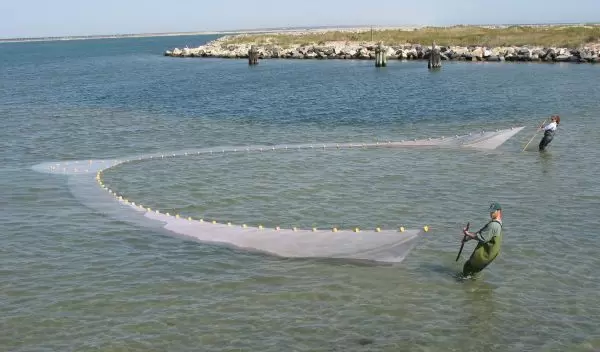
Where North Meets South in the Sea
The Atlantic Ocean off Nova Scotia ... and off Florida.
Along some 2,000 miles, its waters go from icy to steamy. Can a marine species live in both temperatures--and everywhere in between?
If it's a small fish known as the Atlantic silverside (Menidia menidia), it can.
The East Coast of North America has one of the fastest water temperature changes, which scientists call a thermal gradient, of any ocean or sea. It plummets 1 degree Celsius for each degree of latitude.
What effect does this steep thermal gradient have on marine species that live along the Atlantic Seaboard? How do they adapt to the extreme differences?
A study by marine scientist David Conover, currently director of the National Science Foundation's (NSF) Division of Ocean Sciences--along with Lyndie Hice and Tara Duffy of Stony Brook University in Stony Brook, N.Y., and Stephan Munch of NOAA's Southwest Fisheries Science Center in Santa Cruz, Calif.--shows that Atlantic silversides reflect the drop in water temperature in changes in their genetics.
Atlantic silversides range from the Gulf of St. Lawrence in Canada to northeastern Florida in the U.S. Walk along any East Coast shoreline and you're likely to see one--or a school of them--flashing silver in the shallows.
The fish are often found swimming in brackish waters, such as near the mouths of rivers and streams that connect with the sea. They're among the most common piscine residents of the world's largest such estuary, the Chesapeake Bay.
The small fish gather in salt marshes, which offer shelter for spawning and a haven from predators such as striped bass.
Atlantic silversides fuel coastal food webs from north to south. They're also a common subject of scientific research because of their sensitivity to environmental changes.
Conover and colleagues recently published the results of their study of these ubiquitous fish in the journal Ecology Letters. Hice is the lead author.
The study, she says, is the most comprehensive look at genetic variation across latitudes in a marine species.
"The Atlantic silverside is a fish that survives in a spectrum of water temperatures. There's also extensive mixing of its populations throughout its range. Scientists once assumed that all such populations would have similar traits, but we found otherwise."
Despite a blending of Atlantic silverside populations across latitudes, "the fish show remarkable genetic differences over very short distances," says Conover.
For example, the fish's maximum growth rate, and its number of vertebrae, are different in populations as little as 60 kilometers (37 miles) apart.
Conover and colleagues conducted experiments on Atlantic silversides from 39 locations along the fish's 3,000 kilometer (1,864 mile) range, mapping genetic variation in growth rate, number of vertebrae and sex determination.
They initially hypothesized that areas along the coastline where there are abrupt changes in climate, such as North Carolina's Cape Hatteras, would be places where the traits of silversides would rapidly shift in concert.
Instead they found that each trait varied uniquely with latitude--and not necessarily where expected.
The growth rate of silversides, for example, is fastest in northernmost populations.
"These patterns tell us that natural selection appears to be acting independently on each trait," says Hice.
Relationships between environmental gradients and local populations within a single species, say the scientists, are more complex than anyone thought.
"Knowledge of the conditions that lead to local adaptations in growth rate and other traits," says Conover, "will improve management of marine species and fish stocks--and our understanding of the effects of a changing environment."
As water temperatures warm with climate change, what will happen to fish like Atlantic silversides?
"Understanding how marine species adapt to changes in climate with latitude," says Conover, tells us a lot about their capacity to weather climate change in the future.
As climate and water temperatures warm, Atlantic silversides may someday splash their way north as far as Newfoundland, Labrador--and well beyond.


